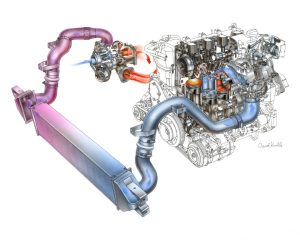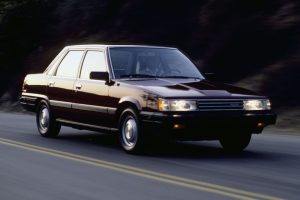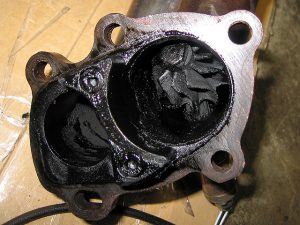It would be idiotic to argue that the dual reservoir master cylinder is a bad idea; that it was better to have a simpler, single reservoir master cylinder – as most new cars had until the early-mid ‘60s – when the dual reservoir master cylinder began to become a standard feature in most new cars. The dual reservoir master cylinder prevents the total loss of braking power by isolating the front and rear brakes. If the front brakes fail because a line breaks – and hydraulic pressure is lost – the rear brakes will still work.
This is what you might call a good idea. 
But how about 19, 20-plus-inch aluminum wheels? Wheels this big – this tall – are now very common.
Are they a good idea?
Well, maybe – if you are driving a high-performance car and drive it in a high-performance manner. Those stiff, short sidewall tires impart quick steering feel and limit roll during cornering. But if you don’t drive that way, they are analogous to a person who doesn’t even jog buying – and wearing – a pair of $220 trail-running shoes. They serve little functional purpose and they waste much money – unless, of course, you don’t think it’s wasteful to spend money on something you don’t really need or use.
Because you like the style.
There’s nothing wrong – morally – with buying something because you like the way it looks, of course – and that is why so many new cars (even some “economy” cars) wear wheels that are at least 17 or 18 inches tall – along with a set of short sidewall tires, which come along for the ride because there’s no longer much room for a taller sidewall tire in the wheelwell. 
But it doesn’t serve much purpose – beyond the “look” – and it adds to the weight (and cost) of the vehicle, as well as the cost of tire replacement, which will generally be necessary more often – because short-sidewall tires tend to wear faster – and cost more, because of their larger size. Ride quality is often negatively affected, too – because short sidewall tires have less give than the taller sidewall tires that used to be typically installed on cars that weren’t high-performance cars.
The alloy wheels are also easier to damage – as by striking a curb – than steel wheels, which are very hard to seriously damage.
Of course, alloy wheels would be a better idea if they were not as wide – and tall. Because they would then reduce the curb weight of the same car otherwise equipped with comparably sized steel wheels and that would result in higher fuel economy, as well as less wear and tear on suspension parts. But the potential benefits of alloy wheels – in a general-use context – are lost when the wheels are sized such that they weigh more than smaller steel wheels and increase the unsprung mass of the car.
Another not-great-idea is the turbocharging of general use engines.
In the past, turbocharging was used to increase the power of an already powerful engine, in a high-performance application – as for example a Porsche 911 turbo. Which was even faster than the already-fast 911, sans the turbo.
Today, turbochargers are used to make up for lost power – as a way to supplement the output of downsized engines that would otherwise be too small – and too underpowered – for the purpose of propelling the vehicle adequately. This is why two-thirds of new cars – including economy and family cars – have turbocharged engines. Typically, they are small four cylinder engines in place of appropriately sized six cylinder engines.
Well, firstly, because these engines aren’t especially fuel efficient – the touted reason for replacing bigger sixes with smaller (and turbocharged) fours – because in order to replicate the power (and performance) of the bigger sixes they have replaced, they are often on boost – which amounts to the same thing as being larger, since the turbo increases cylinder capacity by forcing in more air than the engine could otherwise breath in. That – plus additional fuel sprayed into the cylinders – is how a turbocharger increases power. But there is no making more power without burning more fuel, which means that if you use the boost (as by pressing on the accelerator gas pedal) you will burn more fuel.
In real-world driving, the actual mileage difference between a smaller turbocharged four and the six it replaced is rarely more than 2-3 MPG, a difference arguably not worth the higher cost of the turbocharged engine or the probable shorter service life of the turbocharged engine. Which – remember – is under pressure (i.e., boost) and that imparts additional mechanical force to all of the engine’s internals, including such things as bearings. Which – in a small engine – are also smaller-sized than in a larger engine. They therefore have less surface area to absorb the additional mechanical force and that often leads to faster wear and tear.
No such a great idea.
A really good idea would be simpler, lighter, more durable (less disposable) cars – as opposed to needlessly complex (and therefore more disposable and less durable) heavier cars that are now not just common but unavoidable. If you want a new car.
There are probably a lot of people who would love to be able to buy a mid-sized family car that got 50 miles to the gallon, powered by a sufficiently powerful, non-turbocharged engine that had a simple fuel injection system anyone could work on. That rode on 15 or 16 inch steel wheels and had all season tires that cost $70 each, lasted 40,000 miles and delivered a comfortable, quiet ride.
Such cars used to be available. But that was before someone decided it was a good idea to empower the government to dictate car design.
And that was possibly the worst idea, ever.
Got a question about cars, Libertarian politics – or anything else? Click on the “ask Eric” link and send ’em in! Or email me at EPeters952@yahoo.com if the @!** “ask Eric” button doesn’t work!
If you like what you’ve found here please consider supporting EPautos.
We depend on you to keep the wheels turning!
Our donate button is here.
If you prefer not to use PayPal, our mailing address is:
EPautos
721 Hummingbird Lane SE
Copper Hill, VA 24079
PS: Get an EPautos magnet or sticker or coaster in return for a $20 or more one-time donation or a $10 or more monthly recurring donation. (Please be sure to tell us you want a magnet or sticker or coaster – and also, provide an address, so we know where to mail the thing!)
My eBook about car buying (new and used) is also available for your favorite price – free! Click here. If that fails, email me at EPeters952@yahoo.com and I will send you a copy directly!













The funny thing is that with most race cars… they don’t use all that low profile tires.
Look at Formula 1, at least until this year, they had **13 inch** rims.
NASCAR uses 15×10 inch rims and fat rubber. Although less fat then F1, which needs to be ultra-responsive for their road courses.
When I am driving around fast I want to have compliant rubber and suspension because I want my wheels to stay in contact with the ground. Even on very rough roads.
What is the point to having ultra-stiff suspension and rubber-band thin tires when the only place you can take advantage of them is on glassy-smooth roads?
Thin tires and big rims is just peacock feathers for cars. They give the impression of performance, but mostly they just exist just to prove you have higher then average purchasing resources.
———
As far as terrible ideas for cars…. GDI.
You know what happens when you spray gasoline onto pistons at 10,000 psi?
You wash the oil off the pistons walls.
What happens when you wash the oil off the piston walls?
You get accelerated wear on piston rings.
What happens when you get accelerated wear on piston rings?
You get a car that burns oil.
What happens when you have a 30k mile motor in a “almost new” car that burns oil at about .5-1 quart a 1000 miles and you are told by the manufacturer you don’t have to change the oil until after 5k or 7k or 10k miles?
You get a blown up motor.
Who gets blamed for this?
The car owner.
The result is what?
GDI motors blowing up all over the place and the blame is put on owners for improper maintenance, which while technically true is is also the result of them being lied to.
Blown up motors all over the place. Little 1.3 turbo Fords all over the country. Hondas, Chevys and other little turbo GDI motors with blown up motors.
It’s a problem that very few people are aware of, but is impacting a huge number of people at the same time.
I miss curb feelers.
I do too! I wish somebody still made them. Not kidding.
And the dash compass – mocked them myself for years. Changed my mind after getting turned around leaving the Orlando airport in the dark, the digital read out glowed “N” and I was supposed to be going south.
Can’t bring myself to order up a dash carpet for the 31 year old truck, maybe when I hit 70 in a few years!
How ’bout those “sick” ghetto “spinners” though?! 🤣🤣🤣
You know the ones where the car/suv has to sit like 3′ above the ground… must be something like a 30″ wheel.
gnomesayin’? 😁
Dual masters are definitely a good idea. Once rode my 64 Dodge down an Ozark mountain, with no brakes after blowing a hose. Fortunately, my “emergency brake” worked, mostly. Which is why I would NEVER own a vehicle with an electrical “parking brake”.
Got back to camp, and lo and behold, a scuba tank regulator plug fit the brake manifold port for the blown hose, so I did have half my brakes on the way to the auto parts store.
These turbo-ed and double-turbo-ed 4’s and 6’s have been out long enough now that my friend is starting to regularly see them at his shop, out-of-warranty….and as expected, those motors are often done at barely 100K miles….and that’s after having several major repairs and or turbos replaced (once or more) and sometimes even it’s original engine, while it was still under warranty and well below 100K miles. As if cars hadn’t become disposable enough already…..
Hey Eric, this article needed a picture of a donk!
Eric,
I have a 1997 Toyota T100 I bought 18 months ago.
It had 2015 date stamps on the 15 inch rims and dry rot; so off to Discount.
15 inch tires in my size were special order so off to Craigslist.
I found 2021 Toyota 4Runner 17 inch alloy wheels and new tire “takeoffs” that a guy was selling.
For those who don’t know, takeoffs are brand new wheels and tires that the buyer wanted to immediately replace with (usually) bigger wheels.
I paid the guy $750 cash (I’m sure he reported this sale to the IRS!) and he even threw in a same size new wheel and tire for my expired spare.
He told me sorry, no TPMS. I said good, a 1997 T100 doesn’t have TPMS. I am the TPMS.
This guy 93 sets of new takeoffs in three storage units. All brand new wheels and tires and it was his full time job. How and where he got them (most likely from a dealer connection) I don’t know. Not stolen. This was an upright guy.
Good stuff, ndb!
It always gladdens my soul when I hear such stories.
Anyone driving around here on short sidewall tires will end up with bent rims in no time; would be nice if Klowngress would divert some of the umpteen $billions they’re sending to Ukraine and the IRS and use it to fix the roads.
Old Yeller, my 1979 Pontiac Grand Prix, rode in stock 14” wheels. The stock tire size was 195/75-14. In 21 years I went through many sets of tires, best by far was a set of 205 sized Goodyear Eagle ST, what a perfect tire for that car even The Commander noticed, “it’s like a Cadillac now!”
Best value was Arizonian tires from Discount Tire, smooth, quiet, and cheap! Less than $50 each on sale, although they were barely a 195, but worked dandy on Old Yeller.
My 2003 Escape has 15” wheels, not much selection in 15 inchers now.
The 2018 Jeep has the modern big rims and of course big money tires now as well. And they do wear faster than the old school tall sidewall tires. The stock Michelins were shot at about 36k. Nothing cheap and no bargains in the world of modern motoring.
14″ steelies on my daily driver…1996 Camry…made in Japan.
Mom’s old VW Dasher wagon had 12″ steelies, IIRC.
Time for more hybrid drivetrains instead of turbos.
Toyota shows it can be done at a reasonable price.
The only issue I have with your position on turbos, is that they only served to enhance performance cars. Saab arguably pushed them mainstream by inducing great (at the time) performance from a wimpy engine. Granted, my first car was a 900 turbo, so take that for what it is worth.
I actually kind of miss turbo lag, it was exhilarating when boost surged in.
Hi Mr. Bobo,
I like those Saabs, too – and miss the turbo lag, too! Of course, Saabs were considered specialty-performance cars; quirky things – not for everyone!
Eric,
I loved smoking fox bodies in that thing at stoplights, glorious. It had to be one of the few cases where over-complexity worked in my favor for maintenance; with the reverse hood lift and the upside down and backwards engine layout, replacing spark plugs could be done in 5 minutes.
Also – I dug this up! Thought you might enjoy… https://www.ericpetersautos.com/2011/09/03/2011-12-saab-9-5-not-the-same-old-same-old/
Coworker bought one, “Saab huh, yeah I’d be Saabing too if I bought something that ugly!”
Once upon a time, Saabs were at least available, if not standard, with two cycle engines. I was a very young man in 1972, the only time I ever saw one, while filling it up with gas, and oil, so I have no idea how they performed.
Hi Eric, inspired by a guy here who could not answer a simple question without unleashing gratuitous spouting in order to hear his own voice, I offer you the word I coined to describe the phenomenon: complexification.
Great stuff, Barry – thank you, sir!
I like it, too. And for fun, I offer another version that came to me, inspired by yours:
complexidestruction.
Our local rednecks, mexicans, and blacks all have their unique style of embarrassing rides. It’s their $$$, so whatever. Only thing I wish for is some smart double-E would figure out a way for old farts like me to zap the obnoxious bass speakers that even a partially deaf guy can hear from miles away.
Having spent 20+ years with a Miata as my daily driver, I can unequivocally state that I found no significant difference in handling between 16″ and 17″ wheels. It’s been a long time, so I can’t say the same regarding the earlier models and their 14″ wheels. I can say that the larger wheels do indeed suffer far more damage from the occasional curb contact. The most ridiculous use of high profile wheels and low profile tires is on pickup trucks. They look stupid, and provide no advantage at all, quite the contrary.
Regarding the turbo charged 2.0 engines, there is a fundamental mechanical rule that applies. More power creates more breakage. And 4 cylinders are more susceptible to it than 6 or 8 cylinders are. I suspect that lighter weight transmissions and differentials are similarly effected.
‘That was before someone decided it was a good idea to empower the government to dictate car design.’ — eric
A camel is a horse designed by a committee.
Here’s how a magnificent chimerical horse looks, in the mind’s eye of a know-nothing Kongress Klown:
https://no-kill-switch.ghost.io/content/images/2016/05/hybrid_1.jpg
Or is this ‘Dr’ Fauci, having actually mind-merged with his customary white steed?
A committee-designed horse of a different color, as Joe and Nancy celebrate yesterday’s signing of the Inflation Protection [sic] Act (.jpg image):
https://tinyurl.com/2jd8wx4w
Hey Eric, speaking of good and bad ideas, a little off topic, but what did you ever decide regarding a camper?
Hi Floriduh,
On the camper: I very much want to, but times are tight and my aversion to debt has kept me from pulling the trigger. That said, I have put out some inquiries to several RV manufacturers to see whether I might be able to get the occasional “press vehicle” to try out and write about… fingers crossed.
RE Campers: Better to rent than own unless you’re thinking about becoming a snowbird. You do have the advantage of having one of those work-from-anywhere jobs so you could spend a few weeks on the road at a time. And keep an eye out on Craigslist and eBay (and an ear on the ground). For someone who’s reasonably handy and has a Ikea nearby, trailer interiors aren’t especially hard to build out. And like many things, if you start looking, sellers will find you.
Oh, here’s an idea: Get one this year as a way to test towing capability of a test vehicle. Then it’s a business expense. Next year might be too late since the audit army will be on the march.
Just take a rural drive these days and look at all the properties. Most of the time, I see depressed campers everywhere. They don’t hold up if maintenance is short-cut. Number one thing to notice is the tarps over the top of all the campers… tells you everything you need to know.
I know a guy who bought a new Ram pickup last year for insane money who said it was named “luxury car of the year.” Looks like something a rapper would drive, all rimmed up and tinted out. Then he tells me he can no longer drive on the beach to go fishing because of issues that arise when trying to properly deflate the new truck’s short walled tires.
Hi Anon,
Yup. I’m all for people buying whatever they like but I do not like these jacked-up/tall-walled things riding on gnomesayin’ “rims.”